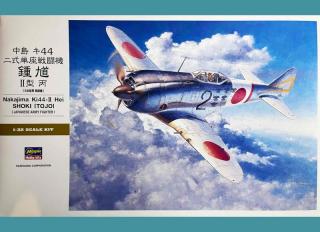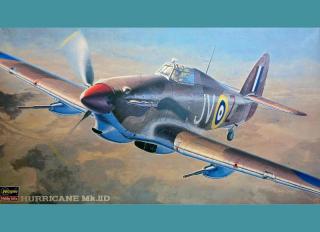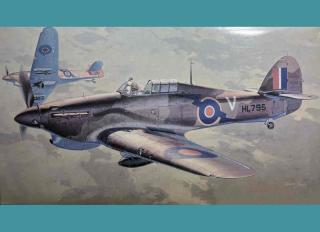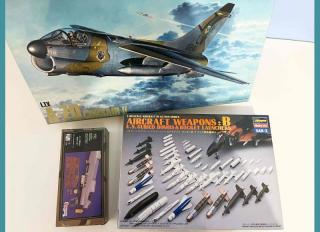Nakajima Ki44-II Hei SHOKI (TOJO)
The Nakajima Type 2 "Shoki" was a single-seater fighter used by the Imperial Japanese Army Air Force (IAAF) during the Second World War. The origins of the design line in the IAAF's high degree of research interest in heavy fighter designs in the late 1930s. In late 1938, the IAAF commissioned the Nakajima Aircraft Company to begin research on a heavy fighter design concept putting an emphasis on speed, with armament consisting of a single cannon and two smaller caliber machine guns. On June 2, 1939, t
- Sklep: Sklep Modelarski, Modelarstwo, Modele do Sklejania - FlyModel / Gomix
- Cena: 250.00 zł
Focke-Wulf Fw190A-4 «GRAF»
The Fw190 was developed to perform a supporting role for the Luftwaffe's mainstay fighter, the Messerschmitt Bf109. The Focke-Wulf was powered by a radial engine - - a rare feature in a European fighter of the era. With a tough construction and superb maneuverability, the efficiency and practicality of the design afforded the Fw190 considerable versatility, and modifications and variants meant the aircraft was able to perform a wide variety of combat roles through to the end of the war. The Fw190A-4 is
- Sklep: Sklep Modelarski, Modelarstwo, Modele do Sklejania - FlyModel / Gomix
- Cena: 190.00 zł
Hurricane Mk I
Sidney Camm, chief designer for the Hawker Engineering Company, had vision to see that the biplane era was nearing its end. In 1925 he designed a monoplane (never built knowing that this was the fighter type of the future . In 1933, under Camm's direction, Hawker began work on a monoplane which was an adaption of their successful Hawker Fury biplane. It initially used a 660 hp Rolls Royce engine, but was changed to the higher potential 1 Rolls Royce PV12, that became the famous Merlin engine. In la
- Sklep: Sklep Modelarski, Modelarstwo, Modele do Sklejania - FlyModel / Gomix
- Cena: 175.00 zł
Hurricane Mk II C
The MkIIC Hurricane came about when the British Air Ministry requested a single seat day and night fighter armed with four 20mm cannon. Hawker proposed fitting cannons to their Hurricane: however the government did not feel that the airframe could take the abuse of the 4 cannons, so they gave the contract to the Westland corporation for their twin engined Whirlwind. There were very few 20mm cannons around in those days and England had approached Hispano Suiza for a license to build their cannons in Englan
- Sklep: Sklep Modelarski, Modelarstwo, Modele do Sklejania - FlyModel / Gomix
- Cena: 175.00 zł
Hurricane Mk II D
Following the Battle of Britain, the Hurricane's days as a front-line fighter came to a close, but it continued to serve proudly as a night-fighter, reconnaissance platform and ground-attack plane in a number of different variations for the rest of the war. It was in this latter role, that a number of unique and effective modifications were seen. Perhaps the most impressive of these was the mounting of 40mm machine cannons to turn the plane into a «tank-buster,» similar to the GermanJu87G. This was
- Sklep: Sklep Modelarski, Modelarstwo, Modele do Sklejania - FlyModel / Gomix
- Cena: 175.00 zł
Hurricane Mk II B
Sidney Camm, chief designer for the Hawker Engineering Company, had vision to see that the biplane era was nearing its end. In 1925 he designed a monoplane (never built ) knowing that this was the fighter type of the future.In 1933, under Camm's direction, Hawker began work on a monoplane which was an adaption of their successful Hawker Fury biplane. It initially used a 660 hp Rolls Royce engine, but was changed to the higher potential I Rolls Royce PV12, that became the famous Merlin engine. In late
- Sklep: Sklep Modelarski, Modelarstwo, Modele do Sklejania - FlyModel / Gomix
- Cena: 175.00 zł
A-7D Corsair II (Zestaw 3 w 1)
The Ling Tomco Vought (L.T.V.) A-7D Corsair II is an offensive aircraft of the U. S. Air Force. The U. S. Air Force acquired the U. S. Navy's A-7A for its excellent ability and low cost as a successor to the F-100 Super Sabre to become its main aircraft. The D model is based on a vastly improved A model. The P TF-30 engines have been replaced by the Allison TF-41 A-1 Turbo engines. Moreover, the aircraft was fitted with an A. P. U. (Auxiliary Power Unit) to reinforce it. The fixed armament consists o
- Sklep: Sklep Modelarski, Modelarstwo, Modele do Sklejania - FlyModel / Gomix
- Cena: 675.00 zł






